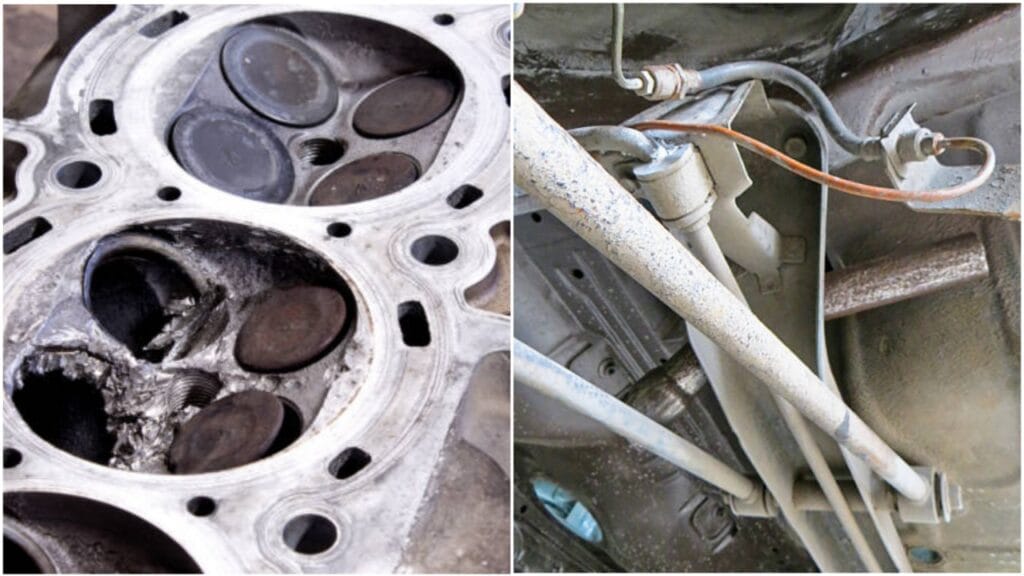A cracked valve cover can lead to several noticeable symptoms that can affect the overall performance of your engine. One of the most common signs is an oil leak. The valve cover seals the engine’s top; when cracked, oil can escape, creating visible puddles or spots under the vehicle.
Oil may also drip onto hot engine components, which could cause smoke or even a fire hazard. Another noticeable symptom is engine misfires. The crack may cause an imbalance in the pressure or allow contaminants into the engine, which could lead to irregular combustion.
If the valve cover is cracked, it might also cause a burning oil smell. In extreme cases, the engine may run poorly, leading to a rough idle or stalling.
Causes of a Cracked Valve Cover
A cracked valve cover typically occurs due to age, excessive heat, or physical damage. Over time, the material of the valve cover—whether metal or plastic—can weaken, especially in high-temperature environments. Exposure to extreme temperatures causes the metal to expand and contract, eventually leading to cracking.
Another common cause is over-tightening or improper installation of the valve cover bolts. If the bolts are too tight, they can put undue stress on the valve cover, leading to fractures or cracks. In some cases, an external force, such as hitting an object under the hood or a manufacturing defect, could result in the crack.
Diagnosing a Cracked Valve Cover
If you suspect your valve cover is cracked, it’s essential to diagnose the issue promptly to avoid further damage to your engine. First, visually inspect the area around the valve cover for signs of oil leakage or pooling. A flashlight can help illuminate hard-to-see areas.
The crack may be small and difficult to spot, but oil stains or a consistent drip can give away its location. Checking for signs of smoke or a burning oil smell under the hood is also a useful diagnostic step. If these symptoms are present, it’s a strong indication that the valve cover may be cracked.
Fixing a Cracked Valve Cover
Fixing a cracked valve cover is crucial for restoring your engine to proper functioning. The solution depends on the severity of the crack. In some cases, especially if the crack is small, you may be able to use a high-quality sealant or epoxy designed for automotive applications.
These products can temporarily seal the crack, but they are generally not a permanent fix. The most reliable and long-lasting solution is to replace the valve cover entirely. This involves removing the old valve cover, cleaning the surfaces, and installing a new cover with fresh gaskets.
When replacing the valve cover, ensure that the new one is compatible with your engine model to prevent future leaks.
Preventing Valve Cover Damage

Prevention is key to avoiding cracked valve covers in the future. Regular maintenance is essential, as engine oil can degrade over time and may cause damage to various parts of the engine, including the valve cover.
Ensure your engine oil is changed at the recommended intervals to maintain optimal engine performance and prevent the valve cover from excessive stress. Additionally, make sure the valve cover bolts are not over-tightened during installation.
Tighten them according to manufacturer specifications to avoid putting unnecessary stress on the cover. Inspect the valve cover periodically for any early signs of cracks or leaks, as early detection can prevent more costly repairs down the road.
Cost and Repair Time
The cost of repairing a cracked valve cover varies depending on the vehicle’s make and model, as well as whether you’re doing the work yourself or hiring a mechanic. If you opt for a professional repair, the cost can range from $200 to $600 or more, including parts and labor.
Replacing the valve cover itself typically costs between $50 and $300 for the part alone, depending on whether you need a metal or plastic cover. Labor costs can vary widely based on your location, but a professional mechanic may charge between $100 and $300 for the repair. The process usually takes 1-3 hours, depending on the vehicle’s complexity.
Long-Term Engine Effects of a Cracked Valve Cover
If a cracked valve cover is left untreated, it can lead to more severe engine problems. One of the most significant risks is the potential for oil to leak onto other engine components, such as the exhaust manifold, which can cause smoking, an increased fire risk, or even engine failure if the oil gets into the ignition system.
Contaminants entering the engine due to a cracked valve cover can cause premature wear on internal components such as the camshaft, timing gears, and valve lifters. This could lead to misfires, loss of power, and higher repair costs down the road.
Conclusion
A cracked valve cover can cause significant issues with your engine’s performance, from oil leaks to engine misfires. Identifying the symptoms early can help you address the issue before it leads to more severe engine damage.
Whether you choose to repair the crack temporarily with sealant or replace the valve cover altogether, acting quickly is key to preventing further complications. Regular maintenance, proper installation, and careful driving can help prevent the valve cover from cracking in the first place.

